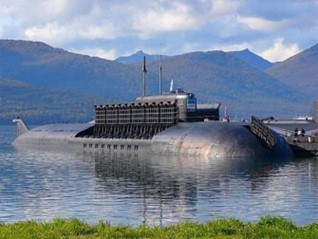Spanish police say Monday they have seized – for the first time – “underwater drones” that can cross the Strait of Gibraltar between Morocco and Spain with up to 200 kilograms of drugs on board, AFP reports.
Three “submarine drones” were seized in the operation – two under construction and one almost finished – “which were to be delivered to French drug traffickers to transport a large quantity of cocaine,” police said in a statement.
https://ziare.com/drona/spania-drone-submarine-transport-droguri-politie-1749601
The “Kalibr” cruise missile strike destroyed two Harpoon anti-ship missile launchers Today, 13:16
The Russian Defense Ministry has confirmed the destruction of two ground-based Harpoon anti-ship missile installations in the area of the settlement. Odessa region estuary. According to army data, the attack on the anti-ship missiles was carried out by Kalibr maritime cruise missiles from the Black Sea. The number of “Kalibr” launched is not named and it is not a fact that they all hit the same designated target. By the way, anti-ship weapons were delivered to Ukraine from the UK. https://topwar.ru/198778-udarom-krylatyh-raket-kalibr-unichtozheny-dve-puskovye-ustanovki-pkr-harpoon.html?yrwinfo=1657304941287961-15301894302437552775-sas3-0767-15b-sas-l7-balancer-8080-BAL-8243

Russia’s naval forces have taken delivery of Belgorod, the first Poseidon nuclear torpedo submarine
The press service of the Sevmash Shipyard in Severodvinsk reported that on 08.07.2022 the first special-purpose submarine Belgorod was handed over to the Russian Naval Forces.
“Today, 08 July, at the Sevmash headquarters, a ceremony was held to sign the act of handing over to the Naval Forces the Belgorod special-purpose submarine,” a press release, taken over by Interfax agency, said.
On this occasion, the Commander-in-Chief of the Russian Naval Forces, Admiral Nikolai Yevmenov, stressed that the most advanced scientific achievements and the latest shipbuilding technologies were used in the creation of the submarine.
“The Belgorod submarine opens up new opportunities for Russia in carrying out various studies and enables scientific expeditions and rescue operations to be carried out in the most remote areas of the Planetary Ocean,” Evmenov said.
https://www.defenseromania.ro/fortele-navale-ale-rusiei-au-primit-in-dotare-belgorod-primul-submarin-purtator-de-torpile-nucleare-poseidon_617171.html

We are pleased to publish: A Guide to Bunkering Malpractices in Shipping Industry.
The guide can be downloaded here: https://www.marineinsight.com/wp-content/uploads/2014/11/bunker-ebook.pdf
On the night of 6-7 July, a team of special operations divers – searched the coastal area of Snake Island for naval mines that could endanger the Ukrainian troops’ despair.
After establishing a safe navigation lane for the Special Operations Forces (SSO) boats, the green light was given for the operation to continue.
The engineers were the first to descend on the island to find and remove mines and booby traps left on Snake Island by the Russian occupation forces. As the Ukrainian military of the Special Operations Forces (SSO) were fulfilling the objectives of their mission – restoring control on Snake Island and flying the Ukrainian flag – several Russian ships began moving towards the island. The Russians left a Pantsir-S1 air defence system and a P-18 radar (metric range, used for aerial surveillance, detection and tracking of aerial targets) on the island. After completing the mission, the Ukrainian Special Operations Forces (SSO) military group left the island. Afterwards, the Russians launched a missile attack on Snake Island.
Azov-Black Sea Maritime Operational Area Russian Black Sea Fleet (BSF) ships continue operations at sea to isolate the northwestern Black Sea. The ships are located mainly along the western and southern coast of Crimea. The frigate Admiral Makarov, the flagship of the Black Sea Fleet of the Russian Federation, leads the surface force grouping. Two submarines (Project 636.3) are at sea. Two Russian BSF vessels patrol the Sea of Azov; one of them, a minesweeper, searches for sea mines. Up to 20 Russian fighters and bombers are on air combat duty. Five Russian missile carriers (two frigates, one missile corvette and two submarines) are ready for a sea salvo; total value is up to 32 Kalibr missiles. All large landing ships of the Russian Black Sea Fleet are anchored in the ports of Sevastopol and Novorossiysk for repair and replenishment. No signs of preparation and formation of maritime desanting.
On the night of 7 July, a group of the combined detachment of the 73rd Special Marine Centre/Armed Forces of Ukraine landed a group on Serpent Island. It examined the island, identified the remains of about 30 different pieces of enemy equipment and weapons and raised the national flag of Ukraine. The group then left the island. Shortly after their withdrawal, the Russian Navy attacked the island with two cruise missiles and hit the island’s jetty. Afterwards, Russian Su-30 and Su-24M planes additionally launched bomb and missile strikes on the island’s ruins.
Russian troops continue to strike Odessa, Mykolaiv and Ochakiv harbours with missiles. Recently, there has been an increase in shelling with MLRS “Smerch” stationed at Kinburn.
The mine situation in the western and central Black Sea remains dangerous. Moreover as of mid-March 2022 more than 10 sea mines have been detected drifting on the surface. Most of them were probably covertly planted by the Russian Federation to discredit Ukraine and block shipments to Ukrainian ports. The Russian Federation states that a storm caused these mines to emerge out of position in the coastal areas of the Ukrainian navy’s mined areas, which were announced in the warning to mariners NAVAREA III 0092/2022. Meanwhile, the drifting mines have different origins and do not belong to mines provided by the Ukrainian Navy. Russian ships and submarines of the Russian BSF auxiliary fleet are likely to be involved in laying the mines under cover. In addition, up to 40,000 mines from WWI and WWII may be on the bottom of the Black Sea (western and northern coasts). The USSR alone laid about 11,000 sea mines between 1941 and 1944. After the collapse of the USSR, no demining activities were carried out in the coastal areas and ports of Ukraine. Every year, dozens of mines, shells and other explosives were found and neutralized on the seabed by divers, fishermen and underwater enthusiasts.
Source: https://www.forumulsecuritatiimaritime.ro/webmail/?_task=mail&_frame=1&_mbox=INBOX&_uid=168&_part=2& _action=get&_extwin=1
Preşedintele Volodimir Zelenski a declarat că arborarea steagului ucrainean pe Insula Şerpilor din Marea Neagră a fost un semn că ţara sa nu poate fi ruptă. În mesajul său nocturn de joi, Zelenski s-a adresat ruşilor, spunând că operația de două luni de recucerire a Insulei Şerpilor a fost un avertisment. „Fiecare căpitan rus, la bordul unei nave sau al unui avion, să vadă steagul ucrainean pe Insula Şerpilor şi să ştie că ţara noastră nu va fi ruptă”, a spus el. Insula Şerpilor, o bucată de teren la sud de portul Odesa, a devenit un simbol al determinării ucrainene. În februarie, când li s-a cerut să se predea, mica garnizoană ucraineană de pe insulă i-a înjurat pe atacatorii ruşi. Ulterior, Rusia a obținut insula, dar a abandonat-o la sfârşitul lunii iunie, din cauza bombardamentelor venite din tabăra ucraineană. Sursa: https://monitorulapararii.ro/volodimir-zelenski-insula-serpilor-un-avertisment-pentru-rusia-ca-ucraina-nu-va-fi-rupta-1-44647
Ministerul de Externe din Ucraina a anunţat joi că o navă rusească încărcată cu cereale ucrainene a fost lăsată să părăsească portul turcesc Karasu. „Regretăm faptul că navei ruseşti Zhibek Zholy, care era plină de cereale ucrainene furate, i s-a permis să părăsească portul Karasu în ciuda dovezilor penale prezentate autorităţilor turce”, a scris, pe Twitter, purtătorul de cuvânt al Ministerului de Externe, Oleg Nikolenko. Ucrainenii consideră că este o „situaţie inacceptabilă” şi l-au convocat pe ambasadorul Turciei pentru a oferi explicații. Sursa: https://monitorulapararii.ro/ucraina-il-convoaca-pe-ambasadorul-turciei-dupa-ce-o-nava-ruseasca-a-parasit-un-port-turcesc-1-44639
Spre sud: probleme legate de coridoarele de transport
Pe fondul sancțiunilor și al „pivotului logistic”, se acordă multă atenție dezvoltării ITC Nord-Sud. În ultimele săptămâni s-au înregistrat lansări active de servicii pe această rută. Cu toate acestea, are unele provocări și blocaje. Coridorul de transport internațional Nord-Sud are o ramură vestică și una estică, ambele traversând Iranul. Cel de vest prevede transportul de mărfuri rutier prin Rasht, cel de est – pe calea ferată. Punctul final în Iran este portul Bandar Abbas, de unde mărfurile pot fi livrate în India pe mare. Ramura vestică traversează și Azerbaidjanul, cea de est – Kazahstan și Turkmenistan. În plus, este posibil și transportul direct pe apă din Rusia către Iran, pe lângă Marea Caspică. Acest coridor a primit un impuls puternic dezvoltării pe fondul sancțiunilor. Sursa: https://en.portnews.ru/comments/3207/
Cea mai mare navă de cercetare marină din China care a plecat în călătoria sa inaugurală către Marea Chinei de Sud
Cea mai nouă și mai mare navă de cercetare a Chinei este de așteptat să-și facă călătoria inaugurală în Marea Chinei de Sud în octombrie, ca parte a eforturilor Beijingului de a stimula explorarea în apele bogate în resurse. Ceremonia de numire a navei a avut loc luna trecută la Shanghai, relatează South China Morning Posts. Nava a fost construită de șantierul naval Shanghai Jiangnan, constructorul celui de-al doilea și al treilea portavion din China. Nava de cercetare a fost predată cercetătorilor de la Universitatea Sun Yat-sen din Guangzhou. Profesorul Yu Weidong, de la școala de științe atmosferice a universității, a declarat pentru Yangcheng Evening News că nava va naviga către Insulele Paracel în octombrie pentru a studia „aburul granițelor de vest ale Mării Chinei de Sud, precum și apele ei învecinate… că ar putea oferi sprijin științific pentru prevenirea dezastrelor”. Profesorul Yu a adăugat că cercetarea se va adresa unor domenii precum atmosfera oceanică, fundul mării, biologia marina și arheologia. Nava a fost numită „un mega laborator mobil pe mare”, potrivit China Ship News. Detalii cheie: LOA: 114,3 m, latime: 19,4 m, pescaj: 9,3 m, deplasament: 6.880 tone; viteza: 15 Nd; autonomie: 60 de zile; echipaj: 100. Nava de cercetare are 760 m2 pentru laboratoare fixe și peste 610 m2 sunt alocați pentru mai mult de 10 laboratoare mobile tip container, permițând cercetătorilor să colecteze mostre pe mare și să le analizeze la bord, înainte de a transfera datele pe uscat. Sursa: https://en.portnews.ru/news/332007/